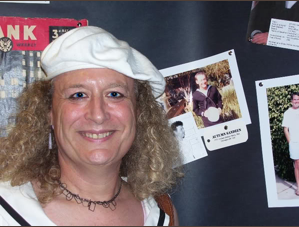
The first day of my transition from male-to-female was Feb. 6, 2003. I had been retired from the U.S. Navy for about 2 1/2 years, and was attending classes at National University in a bid to obtain a Bachelor of Science for Information Systems (IS).
Since I’d been awarded a 60 percent Veterans Administration (VA) Disability Rating, I qualified for Vocational Rehabilitation. My attendance at National University was part of my VocRehab plan; another part of that program was employment as a $10 an hour, 25-hours a week, work-study.
Prior to Feb. 6, I’d been in work-study at the National University Admissions Office. I’d asked to transfer to a work-study position where the office would be friendlier to a transitioning transgender woman.
You see, prior to Jan. 1, 2004, there were no housing and employment antidiscrimination protections for transgender people. How I was treated in state workplaces depended a great deal on the attitudes of the people who worked at those offices.
So Feb. 6, 2003 was not only my first day as Autumn, but it also was my first day at work-study at the transgender-friendly VA Patient Health Library.
On that February day, I looked as good as I possibly could – which is to say at best I only somewhat “passed” as female. I wore a black, wool gabardine skirt suit and a white blouse. I was pretty overdressed for working with VA patients. My make-up had also been professionally done.
I felt euphoric that day. I was living my gender truth for the first day of my life. Passing as female wasn’t as important as living as female. But it didn’t stay that way. Passing became very, very important to me.
So, some of my fashion choices in the first months of my transition … well, like a girl entering puberty I made fashion decisions based on what I liked and not on what looked good on me. In my case, that helped me pass as female.
With certain hilarity, I realize I picked some outfits with serious gothic or punk elements, while other days I dressed matronly in jumpers and blouses. I remember this one black, velvet blouse I wore frequently; it had long, butterfly sleeves with lace on the end of the sleeves. I looked like I was trying to look like Stevie Nicks. I also remember wearing this one white blouse with a huge six or eight inch wide collar. I usually paired that blouse with long jumpers that just screamed “Mom.”
I was also wearing these outfits with my then very dark and heavy beard poking out from under my then heavy pancake make-up. That heavy beard often took away any semblance of passing as my target sex. And since I didn’t start on estrogen until April 10, 2003, my beard grew at full clip. I had to wash off the heavy make-up over my beard every four hours to shave my face. One can easily imagine how much my skin hurt after shaving two and three times a day, day after day, for weeks on end.
Bathrooms were something I thought about a lot. I asked what the San Diego VA Medical Center policy was for transsexuals regarding bathroom use, and I found there was no policy. So with the privacy concerns for the women I worked with, I usually went out of my way to use individual stall restrooms. No one was forcing me into individual stall restrooms, but my choices were made with the comfort level of others in mind.
Yet, I still occasionally had to use multi-stall women’s restrooms, and I don’t forget a funny thing about my use of those multi-stall restrooms.
When I sat on the toilets to pee, I tried to make my pee falling into the toilet water below sound like the pee of other women using the restroom. It was a silly thing for sure –women aren’t concerned about what everyone else’s pee sounds like in the women’s restroom; however, early in transition many trans people fret over many details about the transition process. Looking back from now to then, that aspect of transition now causes me to chuckle.
It’s funny to look back at my transition now, but my issues weren’t funny to me then. For me and many other trans people, “passing” in one’s target sex is an “everything” issue during transition. Failing to “pass” can be difficult and painful.
Kindness towards others in difficult places in their lives is a good thing. Being sympathetic to a person who doesn’t quite fit within the lines of societal sex and gender norms is something I’d encourage my peers – especially my peers in the LGBT community – to do.











